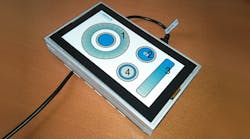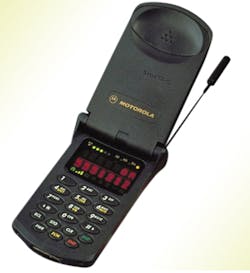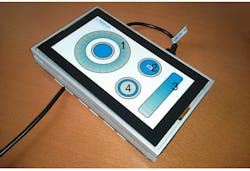This file type includes high resolution graphics and schematics when applicable.
Touch has become a greatly undervalued sense. Six years ago, the iPhone accelerated the move to touchscreen devices. Now we routinely type e-mails and messages on virtual keyboards, yet we’re still often frustrated by miskeyed inputs, accidental touches, and the phone’s attempts to guess what we really meant to type.
There should be a subtlety to touch that removes the need to pay close visual attention to how our fingers or hands move. Think back to texting on an old phone’s keypad, when the key selection was perfect every time, even if the phone did turn “fancy a pint” into “fancy a riot.”
Related Articles
- New Materials Will Replace ITO To Improve Touchscreens
- Design A Lower-Cost Touchscreen
- Design Touchscreen-Based Handheld Systems For Low Power Consumption
With the dominance of touch displays in smart phones and tablets, we need to translate the tangibility of real-world surfaces into the domain of virtual interfaces. Haptic technologies, which deliver touch feedback to the user, can deliver exceptional accuracy and replicate a wide variety of tactile sensations and button presses.
However, the industry is still in the earliest stages of deploying haptics, providing rather raw and unsophisticated sensations that poorly address the way our senses interpret the fusion of sensory inputs—touch, sound, and visual. Fortunately, great leaps are being taken in the understanding of human multi-sensory fusion, and engineering solutions can provide truly lifelike tactile response.
Table of Contents
- First-Generation Haptics
- Second-Generation Haptics
- Third-Generation Haptics
- Haptic Technologies
- The Future: Fourth-Generation Haptics
First-Generation Haptics
I’ll ignore Alexander Graham-Bell’s vibrating phone and skip ahead to the mid-1990s with phones like the Motorola StarTAC (Fig. 1).
Realizing that users did not want to disturb others during meetings but still wanted to be aware of incoming phone calls and text messages, manufacturers added an off-center mass on a motor called an eccentric rotating mass (ERM) to vibrate the device more or less silently—unless it’s on a table, obviously.
Although the vibration alarm is useful for alerting users to a call, the range of sensations it can produce is limited since it has a strong resonant frequency and vibrates the whole device. This form is still in use in many handsets, though, and all that can be done to disguise how it’s a spinning weight is to modulate the duty cycle to create signal variance.
Second-Generation Haptics
But vibrating the entire device enclosure has limitations, not least in terms of power consumption, which is high due to the energy required to shake the mass of the entire device and increases with device size.
Second-generation haptics aimed to separate the part of the device being touched from the part that is not. On a mobile phone, the display can “float” from the body of the device with a flexible mounting with one or more actuators employed to move just the display. This reduced the energy demands and, in turn, increased the sensitivity of the signals that could be imparted, enabling crisper, better defined key-press sensations.
Third-Generation Haptics
These second-generation systems were still limited in the sensitivity of tactile information imparted to the user, and they still transmitted to an entire panel. Further, they could not cope in a multi-touch environment, where you need to accentuate the sensation in one location on the panel and diminish it elsewhere. For the CTRL/ALT/DEL reset on the PC keyboard, for example, the keys are pressed sequentially so the sensation needs to be felt only by the finger making the relevant keystroke.
This is where third-generation haptic interfaces take over. Third-generation haptics enable an app/co-ordinate-specific custom response to be delivered to the point of contact. Techniques include the use of multiple actuators to enable localized haptic sensations to be created and delivered (Fig. 2).
When combined with the more detailed sensations permitted by second-generation haptics, the prospects of creating a powerful perception of surface features, textures, and responses can add greatly to the user experience in mobile phones and tablets. This is especially true for touch-oriented operating systems, such as Windows 8, and the compelling tactile response from touch panels and displays will only increase.
Haptic Technologies
Several techniques are used to deliver tactile sensations to electronic products. The most common techniques include resonant mass movement, electrostatics, and bending waves.
Resonant mass movement includes the ERM described above. Also in this category are linear resonant actuators (LRAs) and some piezoelectric devices enabled with a mass to resonate. Generally, these devices all can be considered masses on springs and have a strong resonant frequency. Techniques of pulsing or modulating this resonance allow a small range of sensations to be created that are discernible from one another.
Also known as electro-vibration, electrostatics use Coulomb’s force, the same force that causes a balloon rubbed against your hair to stick. By creating an electric field using high voltage under the surface of the device’s front panel, an electrostatic haptic actuator can create the feeling of an attraction between the user’s fingers and the touchscreen.
The force is very weak, but the haptic effect can be amplified by using very high-frequency modulation of the electric field.
When the field strength is high, the finger tends to stick to the surface. When switched off, the surface feels normal. In addition to high voltages, though, electrostatic haptics can require complex coatings on the display cover glass and a complex mounting of the display to create effective sensations.
The third class, bending-wave haptics, uses either moving coil actuators or piezoelectric actuators and lower voltages, making them more suited to consumer electronic devices. And unlike electrostatic haptics, bending-wave haptics can directly mimic the feeling of a button press.
Bending waves exploit low-frequency natural resonances in the touch panel or display itself to provide high-fidelity haptic responses including surface textures and key-press feelings, localizing the tactile feedback at specific points on the touchscreen’s surface while diminishing it at other points to create a true multi-touch/mutli-feel environment.
The Future: Fourth-Generation Haptics
With the actuation technology in place, it is possible to go further with high-resolution haptic controllers and build pressure-sensitive interfaces—seemingly compliant surfaces that respond to the way in which the user presses down on the surface.
When we reach out and press a light switch, we are programmed to expect three things: we feel the switch change state, we hear the click, and we see light come on. If any one of these fail, we interpret it as a broken system. Moreover, this sensory fusion allows us to discern quality—the difference between a cheap switch and an expensive one, a shed from a mansion, an old banger from a new BMW. Feel is important and must be integrated into our electronic devices to bring out the best perception of quality, purpose, and productivity.
By generating a force as the user’s finger approaches a spot, it is possible to simulate this surface compliance and so make it appear to the user that the surface is softer than it physically appears. If the force suddenly gives way as the finger pushes down, it is possible to simulate the action of a physical button being pressed and so create the illusion of touching that object. This rapid-response rendering in relation to force or pressure applied is key to the delivery of advanced, compelling haptics (Fig. 3).
We believe our demonstration platform, Bulldog, is the first to offer pressure-sensitive haptics. This kind of response is helpful in creative applications such as art and photographic manipulation where higher pressure is often used to increase the width of a brush, or to alert the user to hyperlinks so a firmer press invokes the link to a Web page. This also eliminates accidental and false touches.
Force detection can be implemented in several ways, from simple force-sensing resistors to printable electro-active inks and computational methods derived from current touch detection technologies. This shift to fourth-generation haptic interfaces means the range of applications that can benefit from touch will be greatly expanded with apps beginning to use the new functionality to add enhanced features and interaction.
James Lewis is CEO of the haptics technology firm Redux Labs (www.reduxlabs.com). The company develops bending-wave technologies to deliver high-quality audio and high-precision haptic feedback systems for the mobile, computing, consumer, automotive, and white goods markets.





